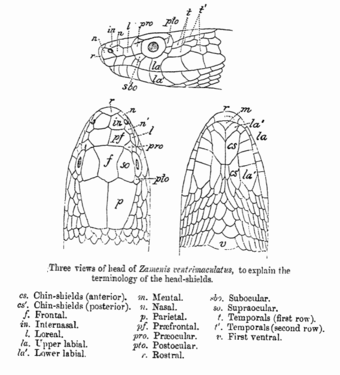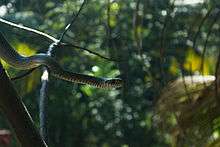Ptyas mucosa
| Ptyas mucosa | |
|---|---|
| | |
| Black interscale stripes are visible on the underside | |
| Scientific classification | |
| Kingdom: | Animalia |
| Phylum: | Chordata |
| Subphylum: | Vertebrata |
| Class: | Reptilia |
| Order: | Squamata |
| Suborder: | Serpentes |
| Family: | Colubridae |
| Subfamily: | Colubrinae |
| Genus: | Ptyas |
| Species: | P. mucosa |
| Binomial name | |
| Ptyas mucosa (Linnaeus, 1758)[1] | |
| Synonyms | |
| |

Ptyas mucosa, commonly known as the oriental ratsnake,[1] Indian rat snake,[3] or dhaman,[1] is a common species of colubrid snake found in parts of South and Southeast Asia. Dhamans are large snakes, growing to 2 m (6.6 ft) and occasionally even to 3 m (9.8 ft). Their colour varies from pale browns in dry regions to nearly black in moist forest areas. Dhamans are diurnal, semi-arboreal, non-venomous, and fast-moving. Dhamans eat a variety of prey and are frequently found in urban areas where rodents thrive. The species is also known as দারাশ (darash) or ধারাজ (dharaj) in Bengali, ගැරඩියා (geradiya) in Sinhala (Sri Lanka) and ngu sing hang lai in Thai (Thailand), in Kannada language ಜೇರೋತನ (Jerothana), జెర్రిపోతు (Jerri pothu) or Joru pothu or Jerri Goddu ( in.Telugu language), Sara paambu ( in Tamil language) and Bairokh (বাইৰখ) in Assamese language.
- Indian rat sake,
 Common India Rat Snake
Common India Rat Snake
Geographic range
Afghanistan, Bangladesh, Burma (Myanmar), Cambodia, China (Zhejiang, Hubei, Jiangxi, Fujian, Guangdong, Hainan, Guangxi, Yunnan, Tibet, Hong Kong), India, Sri Lanka, Indonesia (Sumatra, Java, Bali), Iran, Laos, West Malaysia, Nepal, Myanmar, Pakistan (Sindh area), Taiwan, Thailand, Turkmenistan, Vietnam
Type locality: India.
Enemies
Adult dhamans have few natural enemies other than the king cobras that overlap them in range. Juveniles fear birds of prey, larger reptiles, and mid-sized mammals. They are wary, quick to react, and fast-moving. [4]
Dhamans and related colubrids are aggressively hunted by humans in some areas of their range for skins and meat. Harvesting and trade regulations exist in China and Indonesia but these often go ignored.[5]
Description
Description from Boulenger's Fauna of British India: Reptilia and Batrachia volume of 1890:
- Snout obtuse, slightly projecting;
- eye large; rostral a little broader than deep, visible from above;
- suture between the internasals shorter than that between the prefrontals;
- frontal as long as its distance from the end of the snout, as long as the parietals or slightly shorter;
- usually three loreals;
- one large preocular, with a small subocular below;
- two postoculars;
- temporals 2+2;
- 8 Upper labials, fourth and fifth entering the eye;
- 5 Lower labials in contact with the anterior chin shields, which are shorter than the posterior; the latter in contact anteriorly.
- dorsal scales in 17 rows at midbody, more or less strongly keeled on the posterior part of the body.
- Ventrals 190-208;
- anal divided;
- subcaudals 95-135, divided.
Brown above, frequently with more or less distinct black crossbands on the posterior part of the body and on the tail;
- young usually with light crossbands on the front half of the body.
- Lower surface yellowish;
- the posterior ventral and the caudal shields may be edged with black.[6]
It is the second largest snake in Sri Lanka, after Indian Rock Python.

Behavior
Dhamans, though harmless to humans, are fast-moving, excitable snakes. In captivity individuals remain highly territorial and may continue to defend their turf aggressively, attempting to startle or strike at passing objects. Dhamans are diurnal and semiarboreal. They inhabit forest floors, wetlands, rice paddies, farmland, and suburban areas where they prey upon small reptiles, amphibians, birds, and mammals. Adults, unusually for a colubrid, prefer to subdue their prey by sitting on it rather than by constricting, using body weight to weaken prey.[4][7]
Dhamans mate in late spring and early summer, though in tropical areas reproduction may take place year round. Males establish boundaries of territory using a ritualised test of strength in which they intertwine their bodies. The behaviour is sometime misread by observers as a 'mating dance' between opposite-sex individuals.[7] Females produce 6-15 eggs per clutch several weeks after mating.[4][7]
Adult members of this species emit a growling sound and inflate their necks when threatened. This adaptation may represent mimicry of the king cobra or Indian cobra which overlaps this species in range.[8] The resemblance often backfires in human settlements, though, as the harmless animal is then mistaken for a venomous snake and killed.[4][7]
Nomenclature
The International Code for Zoological Nomenclature (ICZN) directs that the grammatical gender of any given species name should follow logically from the gender of its associated genus name. As Ptyas is a feminine word form, the proper form of the species name is mucosa. Reference materials older than 2004 often show the masculine form, mucosus, and the CITES list continues to list the species this way.
Gallery
- Head with open mouth.
- Top view of head.
- View of temporals.
- Underside of head.
- Belly of snake.
- Body and scales.
- Body and scales.
- Body and scales.
- Long tail of oriental rat snake.
- Temporals indicated.
References
- 1 2 3 4 The Reptile Database. www.reptile-database.org.
- ↑ Boulenger, G.A. 1893. Catalogue of the Snakes in the British Museum (Natural History). Volume I., Containing the Families...Colubridæ Aglyphæ, part. Trustees of the British Museum (Natural History). (Taylor and Francis, Printers). London. xiii + 448 pp. + Plates I.- XXVIII. (Zamenis mucosus, pp. 385-386.)
- ↑ Das, I. 2002. A Photographic Guide to Snakes and Other Reptiles of India. Ralph Curtis Books. Sanibel Island, Florida. 144 pp. ISBN 0-88359-056-5. (Ptyas mucosa, p. 43.)
- 1 2 3 4 http://www.snakesoftaiwan.com/Ptyas%20mucosa/species_ptyas_mucosa.htm
- ↑ https://docs.google.com/viewer?url=http%3A%2F%2Fwww.traffic.org%2Fspecies-reports%2Ftraffic_species_reptiles25.pdf
- ↑ Boulenger, G.A. (1890), "Reptilia and batrachia", The Fauna of British India including Ceylon and Burma, London: Secretary of State for India in Council, 1 (Google eBook), retrieved 2012-03-13
- 1 2 3 4 http://www.siam-info.com/english/snakes_ptyas.html
- ↑ Young, B.A., Solomon, J., Abishahin, G. 1999 How many ways can a snake growl? The morphology of sound production in Ptyas mucosus and its potential mimicry of Ophiophagus. Herpetological Journal 9 (3):89-94
Further reading
| Wikimedia Commons has media related to Ptyas mucosa. |
- David, P., and I. Das. 2004. On the grammar of the gender of Ptyas Fitzinger, 1843 (Serpentes: Colubridae). Hamaddryad 28 (1 & 2): 113-116.
- Günther, A. 1898. Notes on Indian Snakes in Captivity. Ann. Mag. Nat. Hist., Series 7, 1: 30-31. (Zamenis mucosus, p. 30.)
- Jan, G., & F. Sordelli. 1867. Iconographie générale des Ophidiens: Vingt-quatrième livraison. Baillière. Paris. Index + Plates I.- VI. ("Coryphodon Blumenbachi, Merr.", Plate III., Figures 2-4.)
- Lazell, J.D. 1998. Morphology and the status of the snake genus Ptyas. Herpetological Review 29 (3): 134.
- Linnaeus, C. 1858. Systema naturæ per regna tria naturæ, secundum classes, ordines, genera, species, cum characteribus, diferentiis, synonymis, locis. Tomus I. Editio Decima, Reformata. L. Salvius. Stockholm. 824 pp. (Coluber mucosus, p. 226.)
- Morris, P.A. 1948. Boy's Book of Snakes: How to Recognize and Understand Them. A volume of the Humanizing Science Series, edited by Jacques Cattell. Ronald Press. New York. viii + 185 pp. ("The Indian Rat Snake", pp. 136–137, 181.)
- Nixon, A.M.A., and S. Bhupathy. 2001. Notes on the occurrence of Dhaman (Ptyas mucosus) in the higher altitudes of Nilgiris, Western Ghats. Cobra (44): 30-31.